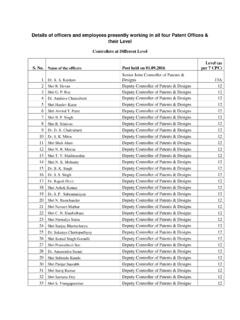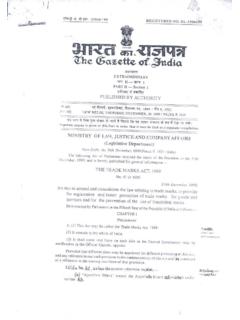Transcription of MANUAL OF PATENT OFFICE PRACTICE AND PROCEDURE
1 MANUAL OF PATENT OFFICE . PRACTICE AND PROCEDURE . Version March 1, 2019. PUBLISHED BY: THE OFFICE OF CONTROLLER GENERAL OF PATENTS, DESIGNS. & TRADEMARKS. BOUDHIK SAMPADA BHAWAN, S. M. ROAD, ANTOP HILL, MUMBAI (INDIA). 1. PREFACE. The Patents Act, 1970 was amended in 1999, 2002 and finally in 2005 to provide for product patents in chemicals, pharmaceuticals, food and agro-chemicals and bring in other necessary amendments in line with Trade Related Aspects of Intellectual Property Rights (TRIPS). Patents Rules have been commensurately amended initially as PATENT Rules, 2003, which were further amended in 2005, 2006, 2012, 2013, 2014, 2016 and 2017. India became signatory to PCT in 1998. Consequently, PATENT filing in India including National Phase applications under PCT has increased exponentially. Indian PATENT OFFICE is a major PCT applications filing country and also functions as ISA/IPEA. under PCT. Indian PATENT OFFICE has been modernized in terms of automation, IT enablement and electronic processing of PATENT applications during last decade.
2 The objective of modernization project was to increase the functional efficiency and streamline the procedures in tune with the international best practices. Considerable changes have been effected in patenting procedures from time to time in accordance with the provisions of the amended Act and Rules and also to bring in automation, electronic work-flow, comprehensive e-filing, simplified and transparent procedures and efficient public service delivery of IP services. The OFFICE has been regularly publishing the MANUAL of PATENT OFFICE PRACTICE and PROCEDURE to codify PATENT procedures for streamlining the functioning, provide benefit to stakeholders and also to provide guidance for prosecution of PATENT applications at PATENT OFFICE . In view of recent amendments of PATENT Rules, reengineering of PATENT procedures and automation in almost all activities in PATENT OFFICE , there has been demand to revise and update the present MANUAL . Accordingly, the present version of MANUAL of PATENT OFFICE PRACTICE and PROCEDURE , hereinafter referred to as MANUAL , has been prepared , which is yet another step to fulfill our commitments towards more efficiency and transparency in the functioning of PATENT OFFICE .
3 2. This MANUAL may be considered as a practical guide for effective prosecution of PATENT applications in India. However, it does not constitute rule making and, hence, does not have the force and effect of law. The MANUAL will be revised from time to time based on interpretations by Courts of Law, statutory amendments and valuable inputs from the stakeholders. ( Gupta). Controller General of Patents, Designs and Trademarks 3. INDEX. Chapter 01: Introduction .. 5. Chapter 02: Key definitions .. 7. Chapter 03: Filing of PATENT Application .. 12. Chapter 04: Publication of 33. Chapter 05: Provisional and Complete Specification .. 36. Chapter 06: Divisional Application and PATENT of Addition .. 53. Chapter 07: Convention Application, International Application and National Phase 57. Chapter 08: Indian PATENT OFFICE as International Searching Authority and Indian International Preliminary Examination Authority .. 77. Chapter 09: Examination and Grant.
4 87. Chapter 10: Opposition Proceedings .. 131. Chapter 11: Post-grant 134. Chapter-12:Appeals .. 144. Chapter-13: Revocation of 147. Chapter 14: Compulsory Licensing .. 149. Chapter 15: Use of inventions for purposes of Government; Acquisition of inventions and patents by the Central Government .. 161. Chapter 16: PATENT Agents .. 168. Chapter 17: Offences and Penalties .. 174. Chapter 18: General Powers of Controller .. 176. Chapter 19: General Services .. 184. Chapter 20: Scientific Advisors .. 189. Chapter 21: Miscellaneous provisions .. 193. Chapter 22: Time Lines .. 196. 4. Chapter-1: Introduction 1. This MANUAL has been compiled with an intention to codify the practices and procedures being followed by the Indian PATENT OFFICE and is intended to serve as a procedural guide for practitioners and other users of the Indian PATENT System. 2. Indian PATENT OFFICE functions from four locations viz. Delhi, Mumbai, Kolkata and Chennai with defined areas of territorial jurisdiction.
5 Introduction of OFFICE automation and electronic processing of PATENT applications has resulted in substantial uniformity and transparency in functioning. Complete file wrapper in respect of published PATENT applications including information related to publication, examination reports, status of application, amendments, grant, opposition, renewal and decisions of controllers as well as legal status of patents in the form of electronic PATENT Register has been made available to the public. This MANUAL is expected to bring in further transparency and uniform practices in the PATENT OFFICE . 3. Processing of PATENT applications is a multi-stage process, involving filing of an application, electronic data processing, screening and classification, publication, examination, hearing if required, pre-grant opposition and grant/refusal. Examiner and Controller of Patents on one side and Applicant/Agent and general public on the other are involved in the patenting process.
6 This MANUAL explains rights, functions and responsibilities of all stakeholders so as to ensure smooth functioning of the PATENT system. 4. This MANUAL is intended to spell out PATENT OFFICE practices and PROCEDURE and bridge any information gap that may currently exist in this regard. It is not intended to be an interpretation of the Indian PATENT Law. 5. The PROCEDURE for filing PATENT application and its processing up to grant/. refusal, maintenance etc. is explained in the following chapters except infringement proceedings. Certain matters like exceptions to the rights of patentee, Government use, compulsory licensing etc. have also been included. 6. Some of the key definitions have been explained in Chapter-2. 7. Chapters 3 to 8 deal with the PROCEDURE for filing of PATENT applications including 5. ordinary and PCT national phase applications, convention and PCT international applications, PATENT of addition, divisional application and Indian ISA/IPEA.
7 8. Chapters 9 to 11 relate to examination, grant, pre-grant and post grant oppositions. 9. Chapters 12 to 14 cover the post-grant procedures such as maintenance of PATENT , appeal, revocation, compulsory licensing and use of patents for the purpose of Government. 10. Chapters 15 to 21 relate to PATENT agents, offences and penalties, general powers of Controller, general services, scientific advisors and miscellaneous provisions. 11. Time lines prescribed under the Act and Rules have been specifically dealt with separately in Chapter 22. 12. The Officers functioning under the Act have been vested with statutory powers. They also have some discretionary powers under the Act, which are to be exercised judiciously. As regards the patentability of any subject matter under consideration by an Officer empowered under the Act, he shall not be guided solely by the contents of this MANUAL but shall take judicious decisions based on the Act, Rules and judicial decisions on the matter.
8 However, all officers of PATENT OFFICE shall follow the PROCEDURE set forth in the MANUAL . 6. Chapter 02: Key definitions General For better appreciation of this MANUAL , the user may require to have clear understanding of certain terms which are defined in the Act and Rules. Some of the important definitions are as under. Definitions "Controller means the Controller General of Patents, Section Designs and Trade Marks referred to in Section 73 (1). 2(1)(b), The Controller General of Patents, Designs and 2(2)(a), and Trademarks is appointed by the Government of India 73;. under Section 3 of the Trademarks Act, 1999. The person Section 3 of so appointed will be the Controller of Patents for the Trademarks purposes of Patents Act, 1970. Act, 1999. The Central Government may appoint examiners and other officers with designations as deemed fit, who shall discharge, under the superintendence and directions of the Controller General of Patents, Designs and Trademarks, such functions of the Controller under this Act, as he may authorize in writing from time to time, by general or special order.
9 Controller shall be construed as including a reference to any officer discharging such functions of the Controller in pursuance of Section 73 (3). The Controller General has authorized Assistant Controllers, Deputy Controllers, Joint Controllers and Senior Joint Controllers to discharge most of the functions under the Act. The Controller General has the power to withdraw any matter pending before an officer, by an order in writing 7. and for reasons to be recorded therein, and deal with such matter himself, either de novo or from the stage it was so withdrawn or transfer the same to another officer who may, subject to special directions in the order of such transfer, proceed with the matter either de novo or from the stage it was so transferred. "Government undertaking" means any industrial Section undertaking carried on 2(1) (h), a. by a department of the Government, or Section b. by a corporation established by a Central, 617 of the Provincial or State Act, which is owned or controlled by the Government, or Companies Act, 1956.
10 C. by a Government company as defined in section 617 of the Companies Act, 1956 (1 of 1956), or d. by an institution wholly or substantially financed by the Government. "Invention" means a new product or process involving Section an inventive step and capable of industrial application. 2(1)(j). New invention means any invention or technology Section which has not been anticipated by publication in any 2(1)(l). document or used in the country or elsewhere in the world before the date of filing of PATENT application with complete specification, the subject matter has not fallen in public domain or that it does not form part of the state of the art. "Inventive step" means a feature of an invention Section that involves technical advance as compared to the 2(1)(ja). existing knowledge or having economic significance or both and that makes the invention not obvious to a person skilled in the art. "Capable of industrial application", in relation to Section an invention, means that the invention is capable of 2(1)(ac).







